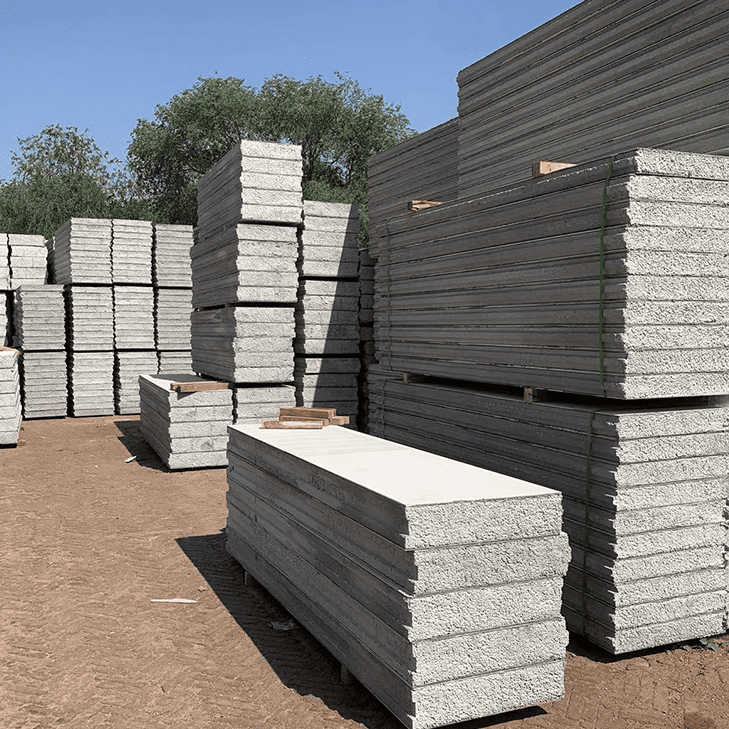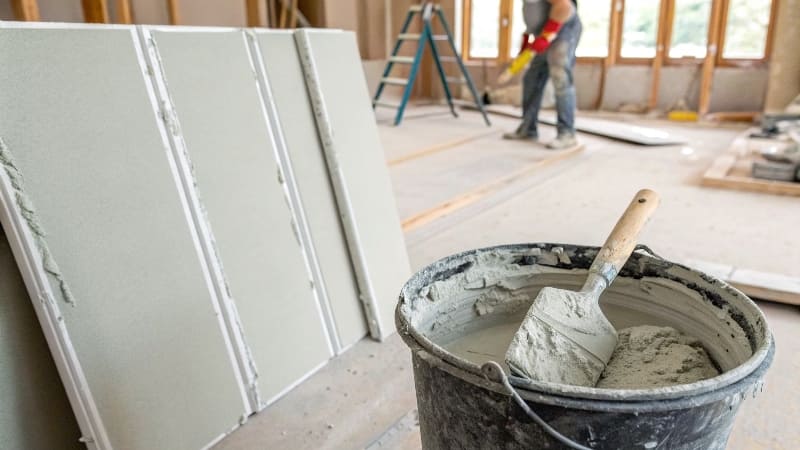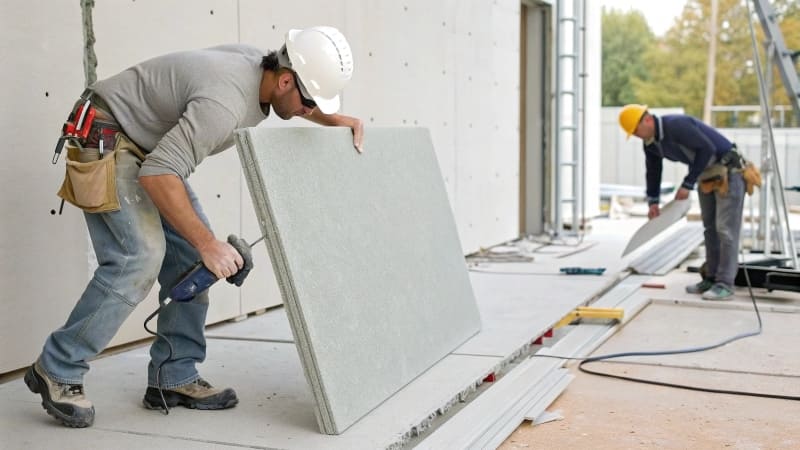Can You Drill Holes in Cement Board?
Many contractors hesitate when drilling cement board, worried about cracking or damaging the material, but understanding proper drilling methods enables successful installations. Cement board drilling requires specific techniques and tools rather than avoiding penetrations entirely for effective construction results.
Yes, you can drill holes in cement board using carbide-tipped masonry drill bits with controlled speed, steady pressure, and proper technique, enabling reliable fastener installation and fixture mounting without compromising board integrity when following manufacturer guidelines.
Through years of cement board manufacturing and installation troubleshooting, I learned that successful drilling depends on understanding material composition and stress distribution rather than material hardness alone, with proper technique preventing common installation failures while maintaining long-term performance.
Will Concrete Crack if You Drill Into It?
Understanding concrete drilling behavior helps prevent damage while achieving necessary penetrations for construction applications. Concrete drilling involves managing stress concentrations and thermal effects that can cause cracking when improper techniques or tools are used.
Concrete may crack during drilling due to excessive speed, improper bit selection, or thermal stress, but proper drilling techniques using appropriate masonry bits, controlled speeds, water cooling, and gradual pressure minimize cracking risk while achieving clean penetrations.
Comprehensive Concrete Drilling Analysis and Crack Prevention Strategies
Concrete drilling involves complex stress interactions and material responses that determine successful penetration without structural damage. During my experience working with diverse concrete applications and drilling failures, I learned that understanding crack mechanisms enables preventive techniques while optimizing drilling efficiency and structural integrity.
Crack formation mechanisms include thermal stress from friction heating, mechanical stress concentrations around drill holes, and aggregate disruption during cutting action. Understanding these mechanisms helps develop drilling strategies that minimize crack-inducing conditions while maintaining drilling efficiency.
Thermal stress develops when drill bits generate excessive heat through friction with concrete surfaces, causing localized thermal expansion that creates stress concentrations exceeding concrete tensile strength. Heat-related cracking appears as radial patterns extending from drill holes.
Mechanical stress concentration occurs at drill hole perimeters where material removal creates stress risers that may exceed concrete capacity under combined drilling forces and structural loads. Stress concentrations increase with improper drilling techniques or excessive penetration rates.
Aggregate effects influence drilling behavior through varying hardness between cement paste and aggregate particles that create uneven cutting resistance. Large aggregates may deflect drill bits while creating stress concentrations that initiate cracking patterns.
Drill bit selection affects crack formation through cutting geometry, material hardness, and heat generation characteristics that influence drilling quality and thermal effects. Improper bit selection increases cracking risk while reducing drilling efficiency.
Speed control manages heat generation and cutting forces that affect crack formation, with excessive speeds causing thermal damage while insufficient speeds reducing cutting efficiency. Optimal speeds balance drilling rate with thermal control requirements.
Pressure application influences stress development through cutting force distribution and penetration rate control that affects local stress concentrations. Excessive pressure increases crack risk while insufficient pressure reduces drilling effectiveness.
Cooling methods including water application or intermittent drilling reduce thermal stress while extending tool life and improving hole quality. Cooling techniques prevent heat-related cracking while maintaining drilling efficiency through temperature control.
Pre-drilling preparation including surface cleaning, marking, and pilot hole creation improves drilling accuracy while reducing stress concentrations. Proper preparation prevents wandering and reduces drilling forces that contribute to crack formation.
Quality control measures include hole inspection, crack detection, and drilling parameter monitoring that ensure acceptable results while identifying potential problems early. Systematic quality control prevents installation failures while maintaining structural integrity.
Repair techniques for minor cracks include epoxy injection, surface sealing, or structural patching that restore integrity while preventing further deterioration. Proper repair methods address crack causes while maintaining long-term performance.
| Crack Risk Factor | High Risk Conditions | Prevention Methods | Quality Indicators |
|---|---|---|---|
| Drill speed | Excessive RPM | Variable speed control | No smoke or burning |
| Bit selection | Wrong type/worn | Carbide masonry bits | Clean cutting action |
| Cooling | No heat control | Water or air cooling | Minimal heat generation |
| Pressure | Excessive force | Gradual, steady pressure | Smooth penetration |
| Hole location | Near edges/joints | Proper spacing/layout | Adequate edge distance |
| Material condition | Weak or damaged concrete | Pre-drilling assessment | Sound base material |
| Tool maintenance | Dull or damaged bits | Regular inspection/replacement | Sharp cutting edges |
| Technique | Improper method | Training and practice | Consistent results |
Can You Hang Things on Cement Board?
Understanding cement board mounting capabilities ensures safe installations while maximizing utilization potential. Cement board provides excellent mounting substrate when proper fasteners and techniques are used according to load requirements and manufacturer specifications.
Yes, you can hang things on cement board using appropriate fasteners matched to load requirements, with light items using standard screws, medium loads requiring specialized anchors, and heavy fixtures needing backing support for safe and reliable mounting performance.
Detailed Cement Board Mounting Analysis and Load Management Guidelines
Cement board mounting involves understanding material strength characteristics, fastener performance, and load distribution principles that ensure safe installations across different weight ranges. During my experience analyzing mounting failures and successful installations, I learned that proper system selection prevents problems while maximizing mounting flexibility.
Load classification helps determine appropriate mounting systems with light loads under 20 pounds using standard fasteners, medium loads 20-50 pounds requiring enhanced systems, and heavy loads over 50 pounds needing structural backing support for adequate safety margins.
Material strength varies by cement board thickness, density, and composition with typical boards supporting 15-25 pounds per fastener when properly installed. Understanding strength limitations guides fastener selection while preventing overloading that causes mounting failure.
Fastener selection affects mounting capacity through different holding mechanisms including friction, mechanical interlock, and adhesive bonding that provide varying performance characteristics. Proper fastener matching optimizes performance while ensuring appropriate safety factors.
Standard screws provide basic mounting capacity for direct attachment into cement board with holding power dependent on thread engagement depth and material density. Standard screws work effectively for light loads within material capacity limits.
Toggle bolt systems increase load capacity through mechanical advantage and load spreading that distribute forces over larger areas. Toggle bolts excel for medium loads when adequate wall cavity depth allows proper installation and expansion.
Anchor systems including expansion anchors and specialty fasteners provide enhanced holding power for demanding applications. Anchor selection should match load requirements while considering installation constraints and performance requirements.
Backing support through additional framing, blocking, or reinforcement plates distributes heavy loads to structural elements beyond cement board capacity. Backing systems enable mounting of heavy fixtures while maintaining safety through proper load transfer.
Installation technique affects mounting reliability through proper hole preparation, fastener installation depth, and torque application that optimize performance. Proper technique ensures predictable capacity while preventing installation-related failures.
Edge distance requirements prevent material failure by maintaining adequate distance from board edges and corners where stress concentrations develop. Minimum edge distances ensure structural integrity while preventing localized failures.
Spacing considerations prevent fastener interaction effects that may reduce overall mounting capacity when multiple fasteners are used. Proper spacing optimizes load distribution while preventing cumulative stress effects.
Load distribution analysis helps understand force paths and stress concentrations that affect mounting performance. Understanding load distribution guides design decisions while ensuring adequate safety margins for various loading conditions.
| Load Range | Typical Items | Fastener Options | Installation Requirements |
|---|---|---|---|
| Light (under 20 lbs) | Towel bars, soap dispensers | #8-10 cement board screws | Pre-drill, proper depth |
| Light fixtures | Pictures, small shelves | Toggle bolts (light duty) | Adequate wall cavity |
| Medium (20-50 lbs) | Medicine cabinets, mirrors | Heavy-duty toggles, anchors | Multiple fasteners |
| Bathroom accessories | Grab bars, toilet paper holders | Specialized bathroom anchors | Proper spacing, edge distance |
| Heavy (50+ lbs) | Wall cabinets, large mirrors | Structural backing required | Framing reinforcement |
| Kitchen cabinets | Upper cabinets, microwave mounts | Blocking or steel reinforcement | Professional installation |
| Structural loads | Handrails, equipment mounts | Engineering analysis | Custom mounting systems |
| Safety-critical | Grab bars, safety equipment | Code-compliant installation | Testing verification |
Which Drill Bit for Cement Board?
Understanding proper drill bit selection ensures efficient cement board drilling while minimizing tool wear and material damage. Different drill bit types provide varying performance characteristics that affect drilling success and long-term tool economics.
Carbide-tipped masonry drill bits are optimal for cement board drilling, providing superior durability and clean cuts through fiber cement composition while maintaining sharpness longer than standard bits and producing precise holes for reliable fastener installation.
Conclusion
Cement board can be successfully drilled using proper techniques and carbide-tipped bits, concrete cracking during drilling is preventable through controlled methods and appropriate tools, cement board supports various mounting loads with suitable fasteners, and carbide-tipped masonry bits provide optimal performance for cement board drilling applications.



